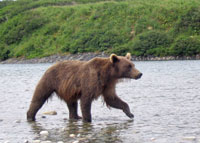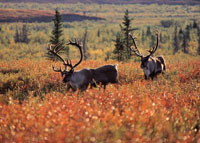When to Go
Wildlife Viewing
Spring, summer, winter or fall, there’s always wildlife to see in Alaska. The key lies in understanding how seasonal activities like migration, breeding, and hibernation affect the behavior of wildlife.
Spring

Spring (March–May) offers some of the best wildlife viewing opportunities before trees and other vegetation leaf out. Ptarmigan migrate to central Alaska river valleys in March. Millions of waterfowl and shorebirds return to the Stikine River Flats, Copper River Delta, and other wetlands in April. As spring progresses, the migration north intensifies. Bears emerge from their dens. Caribou move towards their calving areas. Fresh green vegetation draws Dall sheep, mountain goats, and black bears into areas where they are easily observed. In May, migratory songbirds begin to arrive and seabirds start to gather at southcentral nesting colonies. Spring is also the best time to see walrus, seals, bowhead whales, and other animals as the ice pack recedes along western Alaska.
Summer

In summer (June–August), bears and other wildlife concentrate along streams where salmon are spawning, mostly from July to November. Deer fawns are born. Moose cows with calves frequent roadsides, muskegs, tall thickets, and old burns. June is the best month to spot unusual birds such as Asian accidentals in western Alaska. July is the best month to visit seabird colonies from Southeast to Northwest Alaska. Fur seal pups are born on the Pribilof Islands and Steller sea lions bear their young in coastal rookeries from July through November. In July, walruses haul out on Round, Little Diomede, and King Islands. Muskoxen begin their rut. Waterfowl concentrate on lakes and lagoons to molt their wing feathers and shorebirds begin flocking in preparation for migrating south. In northern and western Alaska spectacular concentrations of migrating waterbirds occur.
Fall

In autumn (September–October), moose, goats, caribou, and muskoxen are mating, often frequenting open areas. Bears frequent berry patches and salmon streams and geese, cranes, shorebirds, and raptors migrate through various locations in large numbers. Gray, bowhead, and beluga whales migrate along the west coast. In September, moose and caribou begin to rut and aggressive antlered males spar. In October, ivory gulls appear near Point Barrow and brant, emperor geese, and Steller’s eiders congregate at Izembek Lagoon. Ptarmigan flock in subalpine areas. Hares, arctic fox, ptarmigan, and lemmings turn white. Caribou migrate to their winter ranges.
Winter

In winter (November–February), movement is less obscured by vegetation so animals are easier to spot. In November, the largest bald eagle concentration in the world can be observed along the Chilkat River near Haines. Dall sheep, deer, and mountain goats are in rut in late fall but as the snow deepens, goats move to old-growth forests, Dall sheep to windblown ridges, and deer to beaches. Tracks of wolves, lynx, marten, mink, river otter and fox are easily seen in the snow. Resident birds like woodpeckers, chickadees, redpolls, jays, and grosbeaks frequent birdfeeders. A surprising number of waterbirds concentrate in bays during the winter and several species that occur in remote areas can be easily viewed near coastal towns. Owls begin evening courtship hooting in February.
More detailed information is listed in our regional wildlife viewing calendars. If you want to join others in celebrating and learning about seasonal activities of wildlife, be sure to peruse our list of wildlife festivals around the state.
